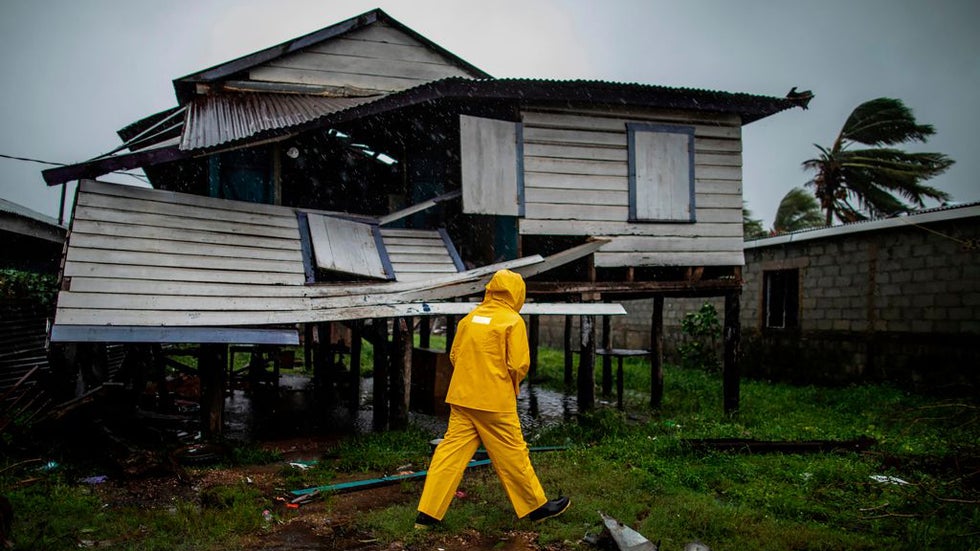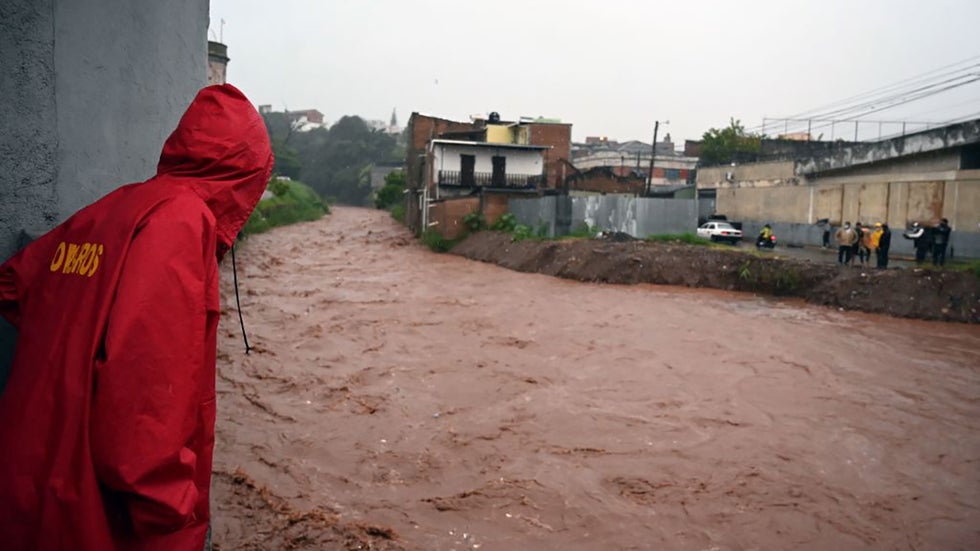Jan Wesner Childs
Thousands of people across Central America face a lack of drinking water, food and basic supplies after back-to-back hurricanes slammed the region, destroying homes, hospitals and other critical infrastructure and piling one disaster on top of another.
"Hurricane Iota made landfall in a region struggling to recover from the widespread devastation caused by Hurricane Eta, which left tens of thousands homeless just two weeks ago," Raul Pineda, Latin America emergency response coordinator for the aid group Americares, said in a news release.
(WATCH: Parade of Storms is Tropical Tragedy for Central America, Louisiana and Vietnam)
Iota came ashore Tuesday in Nicaragua, just 15 miles from where Eta made landfall on Nov. 3. Both were Category 4 hurricanes at landfall.
 A man looks at a damaged house after the passage of Hurricane Iota, in Bilwi, Puerto Cabezas, Nicaragua, on Tuesday, Nov. 17, 2020.
A man looks at a damaged house after the passage of Hurricane Iota, in Bilwi, Puerto Cabezas, Nicaragua, on Tuesday, Nov. 17, 2020.Countries hit by Eta were still assessing damage and beginning the recovery process when Iota struck. The number of people affected by Eta was still going up when Iota brought the second act of this hurricane season's one-two punch to the region.
"So this is very much still (a) developing emergency on top of which now slams another emergency with potentially catastrophic consequences," Jens Laerke, spokesperson for the U.N. Office for the Coordination of Humanitarian Affairs, said in a news release Tuesday.
Eta caused widespread flooding and landslides that left at least 130 people dead and dozens of others missing or presumed dead. At least 19 deaths have so far been blamed on Iota.
The official death toll from Iota in Nicaragua rose to 16 on Wednesday, according to the Associated Press.
As many as 30 people were feared to have been buried in a landslide caused by rain from Iota in Matagalpa, Nicaragua, La Mesa Redonda reported.
Colombia President Iván Duque Márquez said two people were killed and one was missing after Iota passed over Providencia, a small island in the Caribbean Sea about 140 miles off the coast of Nicaragua.
News reports said 98% of the island's infrastructure was damaged and a hospital was destroyed. Homes and buildings were heavily damaged.
Márquez said more than 112 people, including tourists and those with health problems, were evacuated from the island. Six were injured, he added. Fifteen tons of supplies, as well as nearly 200 troops and medical personnel, were being sent to the 10.5-square-mile island where about 5,000 people live.
"It is destroyed," Mateo Posada, a tourist who was evacuated, told La Prensa Latina. "In Providencia, there is not a single house that is well – all the houses are destroyed, all the vegetation is destroyed."
 Locals look at the rising level of the Chiquito Tiver, in the La Hoya neighborhood of Tegucigalpa, Honduras, following the passage of Hurricane Iota on Tuesday, November 17, 2020.
Locals look at the rising level of the Chiquito Tiver, in the La Hoya neighborhood of Tegucigalpa, Honduras, following the passage of Hurricane Iota on Tuesday, November 17, 2020.With sustained winds of 155 mph, Iota ripped roofs off homes and trees. Boats and other debris were strewn across yards and roadways.
"The island was destroyed and all the houses were erased. No house was left standing. Everything is destroyed," said Adrián Villamizar, an evacuee and pastor of the island's Adventist Church who was evacuated from Providencia.
More than 260,000 people in Colombia are estimated to have been affected by the hurricane, according to the European Commission's humanitarian aid agency. The agency said 63,000 people in Nicaragua were evacuated to 600 shelters. Thousands of people were also evacuated in Honduras.
"We are facing an incredible emergency," said Mirna Wood, vice president of the Miskito ethnic group in Honduras’ far east Gracias a Dios region, according to the AP. "There is no food. There is no water."
About 40,000 people in the area had moved to shelters. Some people had to be rescued, Wood said.
Officials in Panama said one person was killed and one was missing in Nole Duima in the Ngäbe Buglé region.
The Weather Company’s primary journalistic mission is to report on breaking weather news, the environment and the importance of science to our lives. This story does not necessarily represent the position of our parent company, IBM.
The Weather Company’s primary journalistic mission is to report on breaking weather news, the environment and the importance of science to our lives. This story does not necessarily represent the position of our parent company, IBM.

No comments:
Post a Comment